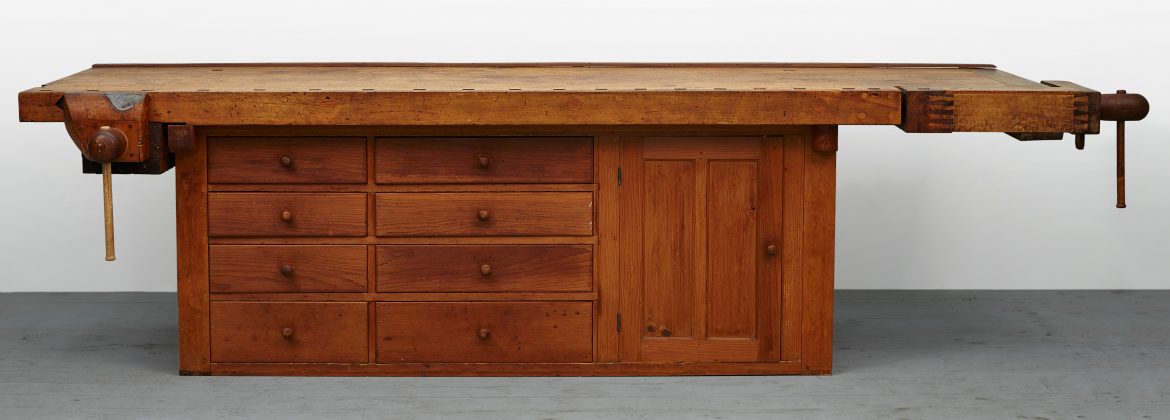
Cabinetmakers’ Workbench, North Family, Mount Lebanon, New York, ca. 1840s, Shaker Museum | Mount Lebanon, 2013.13.1. Matthew Kroening, photographer.
This workbench is one of those objects that is everything one expects of something the Shakers made and used: beautiful, simple, substantial, and useful. The workbench was probably made in the 1830s or 1840s. It is nine feet four inches long, nearly three feet deep (small for a Shaker workbench), and is well fitted out […]

Cabinetmakers’ Workbench, North Family, Mount Lebanon, New York, ca. 1840s, Shaker Museum | Mount Lebanon, 2013.13.1. Matthew Kroening, photographer.
This workbench is one of those objects that is everything one expects of something the Shakers made and used: beautiful, simple, substantial, and useful. The workbench was probably made in the 1830s or 1840s. It is nine feet four inches long, nearly three feet deep (small for a Shaker workbench), and is well fitted out with eight drawers and a cupboard for tools. It has all the appropriate vises to hold materials in place while the cabinetmaker is working. In the late 1920s or early 1930s, William F. Winter, Jr., photographed the workbench as it had been installed by the Shaker workshop. In 1937 this photograph was used by Edward and Faith Andrews in their book Shaker Furniture: The Craftsmanship of an American Communal Sect (Plate 48). In the Andrews’ notes on this photograph they described the workbench as being, “In the brethren’s shop at the North family, New Lebanon. Used by the last elder and minister at the central Shaker society.”

Photograph of Cabinetmakers’ Workbench in Place at the North Family, North Family, Mount Lebanon, New York, 1937, William F. Winter, photographer, Photograph in private collection.
The large brick building at the North Family that is currently called the Brethren’s Workshop (1829) – although historically it was just called the Brick Shop by the Shakers – was the logical place to look for a location that fit Winter’s photograph. A careful examination of the photograph – looking at the distance between the top of the windows and the ceiling and the direction of the floorboards – determined the photograph could not have been taken in that building. But, by roughly measuring the distance between windows as compared to the length of the workbench it appeared that the only other building standing in 1937 in which a male member of the family might have had a shop was the Deacons’ Workshop (rebuilt 1856). The “last elder and minister at the central Shaker society,” or Mount Lebanon, was Elder Walter Shepherd (1852-1933). Elder Walter joined the North Family in 1888. Born in England, Shepherd had contact with Elder Frederick W. Evans during Evans’s 1886 missionary tour to England and decided to come to the United States. Brother Walter fit well in the family but, possessing much needed skills and the proper temperament, in 1895 was sent to lead the Shaker Society at Enfield, Connecticut. He returned to the North Family in 1917 and in 1919 became the lead in the Shaker Ministry. At his death in 1933, the male members of the Ministry relocated to the Shaker community at Canterbury, New Hampshire.
Although Elder Walter is not known to have worked as a cabinetmaker, it was traditional for most male Shaker leaders to have a workshop in which to perform whatever kind of hand labor they could contribute to the Church.

Photograph of Cabinetmakers’ Workbench in the Upton Home, Brunswick, New York, 1966, William Tague, photographer. From, “Living with Antiques: Shaker Adventure,” The Magazine Antiques 90 (July 1966), p. 87.
The bench was acquired in 1956 by Charles and Helen Upton. Both of the Uptons were teachers at Russell Sage College and were collectors of Shaker objects and students of Shaker history. The Uptons’ son Jim remembers the circumstances of the purchase. The Uptons had asked Hancock Sister Frances Hall if she had any tailoring counters available for sale. Sister Frances took them into the basement of the Trustees’ Office at Hancock to show them a counter. While there, they saw the workbench. It, like so many other things, had been brought over to Hancock in 1947 when the North Family at Mount Lebanon closed. Liking the workbench more than the counter, the Uptons asked to purchase the workbench. Sister Frances agreed. After the expected struggle to move the large workbench into their home in Brunswick, New York, it became the centerpiece of their study.
The Uptons and their children Russ and Jim were deeply interested in Shaker history. Charles and Helen regularly included the Shakers in the courses they taught, Jim wrote his honors thesis at Union College on “The Shakers as Pacifists in the Period between 1812 and the Civil War,” and Charles, Helen, and Jim all served on the museum’s Board of Trustees. Charles passed away in 1980 and in 1988 Helen began transferring some of the objects from their collection to the Shaker Museum | Mount Lebanon. In all, several hundred objects were given to the Museum, including furniture, books, photographs, manuscripts, and ephemera. The bench had already been promised to Jim but in 2013 Jim Upton continued the family’s support of the Museum by giving the Museum the cabinetmakers’ workbench.
This workbench is on view in the Brethren’s Workshop, accessible by guided tour during the museum’s open season.